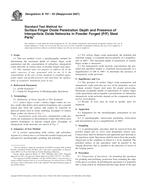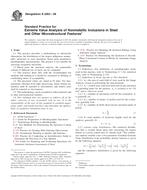Potrebujeme váš súhlas na využitie jednotlivých dát, aby sa vám okrem iného mohli ukazovať informácie týkajúce sa vašich záujmov. Súhlas udelíte kliknutím na tlačidlo „OK“.
ASTM E1245-03(2008)
Standard Practice for Determining the Inclusion or Second-Phase Constituent Content of Metals by Automatic Image Analysis
Automaticky preložený názov:
Štandardné praktiky pre stanovenie zaradenia alebo druhá fáza ústavodarného Obsah kovov automatickej analýzy obrazu
NORMA vydaná dňa 1.10.2008
Informácie o norme:
Označenie normy: ASTM E1245-03(2008)
Poznámka: NEPLATNÁ
Dátum vydania normy: 1.10.2008
Kód tovaru: NS-40992
Počet strán: 8
Približná hmotnosť: 24 g (0.05 libier)
Krajina: Americká technická norma
Kategória: Technické normy ASTM
Kategórie - podobné normy:
Anotácia textu normy ASTM E1245-03(2008) :
Keywords:
exogenous inclusion, feature-specific measurements, field measurements, image analysis, inclusions, indigenous inclusions, light microscopy, oxide, second-phase particles, statistical analysis, stereology, sulfide, Photomicrography, Second-phase particles, Slab/slabs, Specimen preparation (for testing)--metals/alloys, Steel bars, Steel billets and blooms, Stereological measurement, Structural metals/alloys, Sulfide/sulfur environments, Sulfur--steel, Surface analysis--metals/alloys
Doplňujúce informácie
| Significance and Use | ||||||||
|
This practice is used to assess the indigenous inclusions or second-phase constituents of metals using basic stereological procedures performed by automatic image analyzers. This practice is not suitable for assessing the exogenous inclusions in steels and other metals. Because of the sporadic, unpredictable nature of the distribution of exogenous inclusions, other methods involving complete inspection, for example, ultrasonics, must be used to locate their presence. The exact nature of the exogenous material can then be determined by sectioning into the suspect region followed by serial, step-wise grinding to expose the exogenous matter for identification and individual measurement. Direct size measurement rather than application of stereological methods is employed. Because the characteristics of the indigenous inclusion population vary within a given lot of material due to the influence of compositional fluctuations, solidification conditions and processing, the lot must be sampled statistically to assess its inclusion content. The largest lot sampled is the heat lot but smaller lots, for example, the product of an ingot, within the heat may be sampled as a separate lot. The sampling of a given lot must be adequate for the lot size and characteristics. The practice is suitable for assessment of the indigenous inclusions in any steel (or other metal) product regardless of its size or shape as long as enough different fields can be measured to obtain reasonable statistical confidence in the data. Because the specifics of the manufacture of the product do influence the morphological characteristics of the inclusions, the report should state the relevant manufacturing details, that is, data regarding the deformation history of the product. To compare the inclusion measurement results from different lots of the same or similar types of steels, or other metals, a standard sampling scheme should be adopted such as described in Practice E 45. The test measurement procedures are based on the statistically exact mathematical relationships of stereology for planar surfaces through a three-dimensional object examined using reflected light (see Note 1). The orientation of the sectioning plane relative to the hot-working axis of the product will influence test results. In general, a longitudinally oriented test specimen surface is employed in order to assess the degree of elongation of the malleable (that is, deformable) inclusions. Oxide inclusion measurements for cast metals, or for wrought sections that are not fully consolidated, may be biased by partial or complete detection of fine porosity or microshrinkage cavities and are not recommended. Sulfides can be discriminated from such voids in most instances and such measurements may be performed. Results of such measurements may be used to qualify material for shipment according to agreed upon guidelines between purchaser and manufacturer, for comparison of different manufacturing processes or process variations, or to provide data for structure-property-behavior studies. |
||||||||
| 1. Scope | ||||||||
|
1.1 This practice describes a procedure for obtaining stereological measurements that describe basic characteristics of the morphology of indigenous inclusions in steels and other metals using automatic image analysis. The practice can be applied to provide such data for any discrete second phase. Note 1—Stereological measurement methods are used in this practice to assess the average characteristics of inclusions or other second-phase particles on a longitudinal plane-of-polish. This information, by itself, does not produce a three-dimensional description of these constituents in space as deformation processes cause rotation and alignment of these constituents in a preferred manner. Development of such information requires measurements on three orthogonal planes and is beyond the scope of this practice. 1.2 This practice specifically addresses the problem of producing stereological data when the features of the constituents to be measured make attainment of statistically reliable data difficult. 1.3 This practice deals only with the recommended test methods and nothing in it should be construed as defining or establishing limits of acceptability. 1.4 The values stated in SI units are to be regarded as standard. No other units of measurement are included in this standard. 1.5 This standard does not purport to address all of the safety concerns, if any, associated with its use. It is the responsibility of the user of this standard to establish appropriate safety and health practices and determine the applicability of regulatory limitations prior to use. |
||||||||
| 2. Referenced Documents | ||||||||
|
Podobné normy:
Historická
15.3.2007
Historická
1.10.2012
Historická
1.9.2011
Historická
1.2.2008
Historická
1.5.2011
Historická
1.6.2013
Odporúčame:
EviZak - všetky zákony vrátane ich evidencie na jednom mieste
Poskytovanie aktuálnych informácií o legislatívnych predpisoch vyhlásených v Zbierke zákonov od roku 1945.
Aktualizácia 2x v mesiaci !
Chcete vedieť viac informácii ? Pozrite sa na túto stránku.



 ASTM B797-93(2007)..
ASTM B797-93(2007).. ASTM E1351-01(2012)..
ASTM E1351-01(2012).. ASTM E1916-11
ASTM E1916-11 ASTM E2283-08
ASTM E2283-08 ASTM E3-11
ASTM E3-11 ASTM E340-13
ASTM E340-13
 Cookies
Cookies
